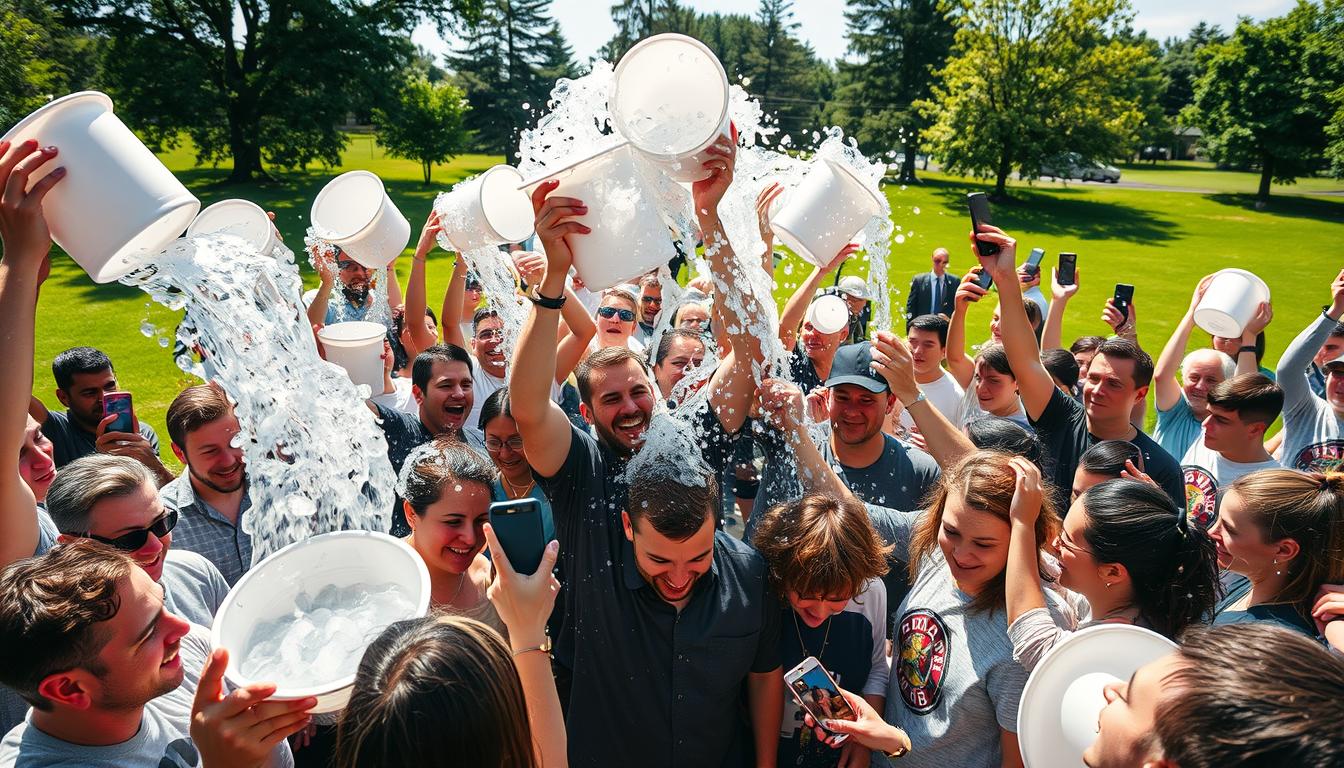
Imagine a simple act that sparked a global movement. In 2014, the Ice Bucket Challenge swept across social media, raising unprecedented awareness and funds for ALS research. This phenomenon saw over 28 million posts and 2.4 million videos shared on Facebook alone, making it one of the most viral campaigns in history.
What made this challenge so powerful? It harnessed the energy of social media trends, blending fun with a noble cause. Celebrities like Bill Gates and Mark Zuckerberg, along with everyday people, joined in, creating a wave of participation that couldn’t be ignored. The challenge not only raised $115 million for the ALS Association but also doubled their annual fundraising efforts.
The timing was perfect—launching in the summer when people were looking for engaging activities. This campaign didn’t just raise money; it transformed how charities approach viral marketing, setting a new standard for awareness campaigns. The funds allocated to research and support services highlighted the challenge’s lasting impact on ALS awareness.
This section explores how the Ice Bucket Challenge became a landmark in viral marketing, offering insights into its success and the lessons it provides for future campaigns.
The Birth of a Viral Movement
The Ice Bucket Challenge began as a modest initiative in the summer of 2014, sparked by ALS patients like Pete Frates. What started as a simple, shareable act quickly transformed into a global phenomenon, captivating millions and raising unprecedented funds for ALS research.
Origins and Grassroots Beginnings
The challenge originated from grassroots efforts, with individuals taking videos of themselves dumping ice water and nominating others to join. This personal, relatable approach resonated widely, turning a simple act into a movement. The nomination mechanic encouraged participation, fostering a sense of community and responsibility.
Social Media as the Spark
Social media platforms like Facebook, Twitter, and Instagram were instrumental in spreading the challenge. Early videos and posts created initial momentum, with over 28 million posts and 2.4 million videos shared on Facebook alone. This digital engagement propelled the challenge to viral status, making it one of the most shared campaigns in history.
Seasonal Timing and Global Relevance
Leveraging the summer season, when people had more leisure time, the challenge encouraged video creation and sharing. The fun, attention-grabbing act of dumping ice water became a symbol of support, capturing the public’s imagination and leading to millions of participants worldwide.
For more details on the challenge’s origins and impact, visit the Ice Bucket Challenge Wikipedia page.
Ice Bucket Challenge Charity Viral Marketing: Strategies and Lessons Learned
The Ice Bucket Challenge’s success can be attributed to several key strategies that made it a landmark in viral marketing. By combining personal stories, celebrity endorsements, and a simple yet engaging concept, the campaign created a powerful formula for success.
Leveraging Personal Stories and Social Proof
Personal narratives played a crucial role in building trust and encouraging participation. People shared their own experiences with ALS, creating an emotional connection that motivated others to join. Social proof, like seeing friends and celebrities participate, added credibility and compelled many to take part.

Celebrities such as Oprah Winfrey and LeBron James brought national attention to the cause. Their involvement not only boosted visibility but also encouraged others to follow suit, demonstrating the power of influencer endorsements in viral campaigns.
The Role of Celebrity Endorsements
Celebrity participation elevated the campaign’s credibility and reach. Their involvement introduced the challenge to new audiences, making it a household name. This strategy highlighted the importance of influencer marketing in scaling a campaign’s impact.
Simplicity, Nomination, and Street Credibility
The campaign’s simplicity was key to its success. Participants could either take the challenge or donate, making it accessible to everyone. The nomination process added a fun, competitive element, encouraging others to join through playful peer pressure.
This approach created shareable, easily replicable content that spread quickly across social media. The challenge’s design ensured it could be easily imitated, a crucial factor in achieving viral success.
These strategies offer valuable lessons for future campaigns. By blending emotional appeal with effective marketing, the Ice Bucket Challenge set a new standard for cause marketing, demonstrating how to engage a wide audience and drive significant impact.
Case Study Analysis: Campaign Execution and Impact
Discover how a simple idea evolved into a global phenomenon, reshaping charitable fundraising forever. The Ice Bucket Challenge offers a masterclass in viral engagement and impactful results.
Interactive Social Media Engagement
The campaign harnessed social media’s power to create a wave of participation. Over 17 million people uploaded challenge videos, generating over 10 billion views on Facebook alone. This level of engagement transformed the initiative into a cultural sensation, with each video sparking new conversations and nominations.
| Metric | 2014 Results | Previous Year |
|---|---|---|
| Funds Raised (ALS Association) | $115 million | $2.8 million |
| Challenge Videos | 2.4 million | N/A |
| Facebook Views | 10 billion | N/A |
Fundraising Milestones and Measurable Results
The challenge achieved unprecedented success, raising over $220 million globally. This surge in donations led to a 1,000% increase in ALS-related Google searches, significantly boosting awareness. The funds contributed to breakthroughs in ALS research, including the identification of the NEK1 gene.

Media Coverage and Long-Term Legacy
Traditional and social media played pivotal roles in the campaign’s success. Over 1.5 million tweets and extensive news coverage turned the challenge into a national sensation. The campaign’s impact continues to influence digital fundraising strategies, setting a new benchmark for viral campaigns.
Learn more about the importance of search engine optimization in amplifying campaigns like this one.
Conclusion
The Ice Bucket Challenge stands as a testament to the power of creativity and strategic planning in driving social change. By blending personal stories with a simple, shareable concept, the campaign harnessed the energy of social media to raise over $115 million for ALS research, a significant increase from previous years.
The success of this movement highlights the importance of teamwork and a clear call to action. Celebrities and everyday people alike joined forces, creating a wave of participation that couldn’t be ignored. The campaign’s impact extended beyond fundraising, as it sparked crucial conversations about ALS research and set a new standard for viral campaigns.
As you reflect on this case study, consider how these strategies can enhance your own marketing efforts. The perfect blend of creativity, timing, and social media power offers valuable lessons for future campaigns. For more insights into effective marketing strategies, explore innovative approaches that drive meaningful change.

 The Ice Bucket Challenge: Charity Meets Viral Marketing for ALS Research
The Ice Bucket Challenge: Charity Meets Viral Marketing for ALS Research
0 Comment